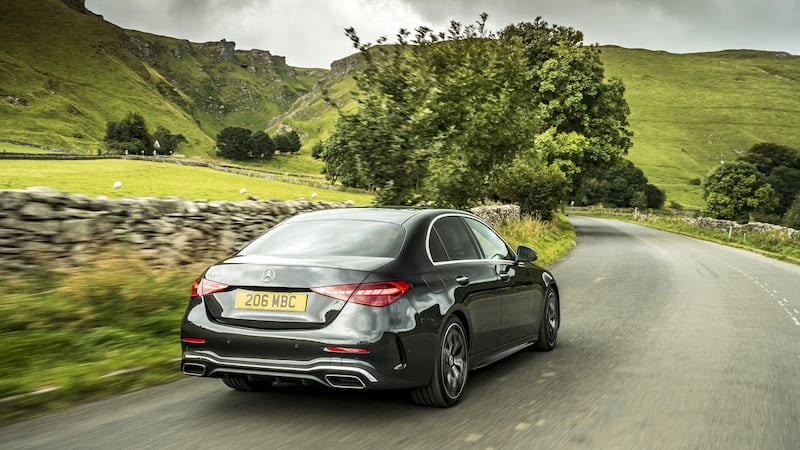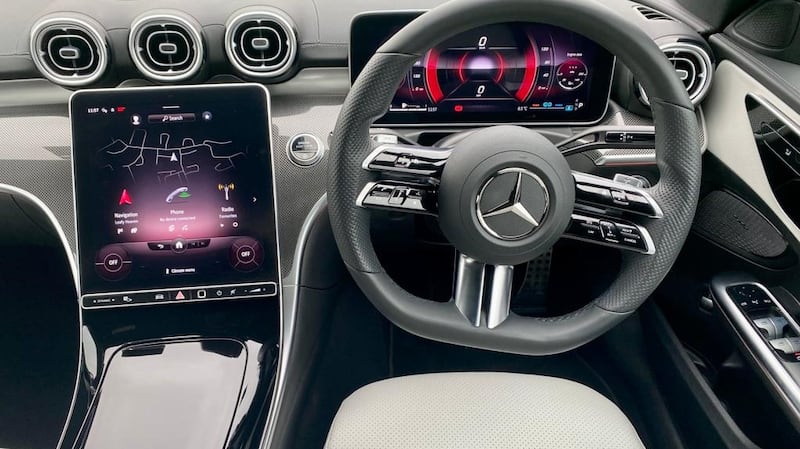1,469km: that was the remaining range of the new Mercedes C-Class diesel test car when I picked it up.
The estimated range is nestled in the bottom corner of the driver’s digital display, but as a reminder why many buyers are still sticking with diesel it should be announced with a Ryanair-style trumpet fanfare every time you turn on the car.
The company that created the first automobile has promised 1,000km range on a single charge from an electric vehicle concept, the Mercedes EQXX, unveiled last month. That will be a stunning engineering coup when it finally hits the market. Yet for this diesel-engined C-Class that’s achievable in less than a full tank.
There was a time when reviews of new premium diesel saloons would be big news. These days it seems like testing a pony and trap.
There is nothing as fickle as the Irish motoring public. The Economic and Social Research Institute published a journal article this month with the catchy headline “Experimental evidence for the effects of emissions charges and efficiency information on consumer car choices”.
It concluded: “These findings imply that financial incentives and subtle presentational changes can alter consumer choices, with the potential to promote sustainable consumption.”

In fairness, it hardly needed a team of economists to spot that trend.
In July 2008, Irish motor tax policy went from a system based on engine size to one based on CO2. Overnight diesel sales overtook petrol ones. In 2007, 71 per cent of new cars were petrol. By 2012, 74 per cent of new cars were diesels.
In January 2020, a new tax based on Nitrogen Oxide (NOx) emissions – largely from diesels – was introduced. By 2021, diesel sales were 33.5 per cent.
So Irish car buyers are strongly influenced by tax policy. That explains the engine choices, but not the SUV fixation. Why are so many saloon buyers migrating to hiked-up hatchbacks? No doubt there’s a doctoral dissertation in that for someone.
It might not be the big-draw heavyweight showdown it once was, but the premium saloon market is still the heartland for German premium brands.
And in this class, the battle royale is the head-to-head of the Mercedes C-Class and the BMW 3 Series. Recently, the Bavarians have had the upper hand.
This is a completely new take on the Mercedes entrant, and as such is important not just for saloon buyers but also those crossover fans, for it provides the underpinnings and parts bin for the popular GLC SUV.
Passenger space
The big news is the size: it is longer wider and higher set off the ground. Debadge the boot and you could easily mistake it for an E-Class. Which is largely the point for many people.
There are trade-offs with all this, of course. Passenger space in the back has been improved so adults won’t gripe if they find themselves in the rear, but in turn the bootspace is now 455 litres, 25 litres less than its BMW rival.
The bigger news is the interior trim. It’s taken a lot of cues from the flagship S-Class, particularly the sweeping portrait-format touchscreen in the centre.
The big centre touchscreen is impressive, making the higher-placed BMW screen look a little old-school. For newcomers, the Mercedes MBUX system can seem a bit daunting and some will lament the lack of physical buttons, but it’s pretty self-explanatory.

In normal life, the driver will mostly engage with all the features via the digital binnacle and the steering wheel controls. And Mercedes deserves a word of praise for its voice control system, which not only managed to decipher my mumbling but also understood my wishes. In a like-for-like against the equivalent BMW system, the Mercedes gets five stars.
Those steering wheel controls are also ideally located and touch sensitive, so you sweep your thumb to change between screens.
Up front is a 2-litre diesel, probably the last hurrah for this oil-burner, as Mercedes promises to be a fully-electric brand by 2030 (market conditions allowing). It’s strange how the rattle of a cold diesel sounds so much noisier now we have become accustomed to the silent whoosh of electric motoring. And a 0-100km/h time of 7.7 seconds seems sedate compared with the immediate acceleration of EVs. Yet, there is plenty to like with this car. Adding a 48-volt mild hybrid system helps improve fuel economy, makes the throttle more responsive and keeps the CO2 figures looking smart.
There is no escaping the fact that diesel seems gruff in the current age, and it’s hard to marry the level of refinement of the cabin, the sleek styling of the exterior and that engine rattle. By opting for the four-cylinder 2-litre diesel over a six-cylinder alternative, Mercedes engineers tied their own hands. They make up for it, however, with an engine that’s responsive and well matched to the company’s top-notch nine-speed automatic transmission.
And while it doesn’t have the immediate pace of an electric car, it offers a welcome reminder of the fun you can have matching a sharp steering system with a rear-wheel drive set-up and introducing it all to the right back roads. It’s a level of engagement you just don’t get from heavy, high-riding EVs.
Fun to be had
This is not a true sports saloon but there’s fun to be had, and you don’t have to sacrifice ride comfort. Where its Bavarian rival can be guilty of carrying the ruts and bumps of the road into the cabin, the C-Class does a better job at soaking them up through the suspension. The trade-off is slightly more bodyroll in the bends.
There’s no question this is a handsome car, more of a head-turner than either the 3 Series or Audi A4. The BMW pips it for its slightly sharper driving appeal, but the C-Class delivers a more adult, grown-up drive mixing comfort and refinement with new tech.
The best praise it can get is that life with the new C-Class would make you wonder whether you need bother stepping up to E-Class.
Mercedes C-Class C200d AMG saloon: the lowdown
- Power: 1993cc, 163bhp four-cylinder diesel, matched with nine-speed 9G-Tronic auto transmission, putting out 380Nm of torque
- CO2 emissions (annual motor tax): 120g/km (€190).
- Fuel consumption: 4.5 L/100km (63mpg).
- 0-100km/h: 7.7sec.
- Price: €63,330 as tested.
- Verdict: Impressive touches of premium comfort and tech powered by what might be diesel's last hurrah.











